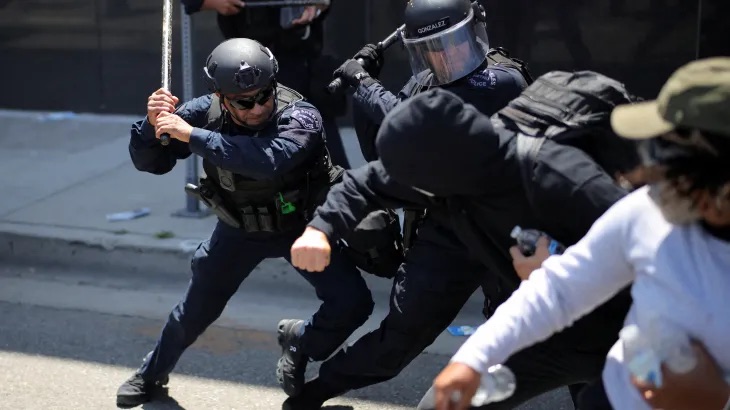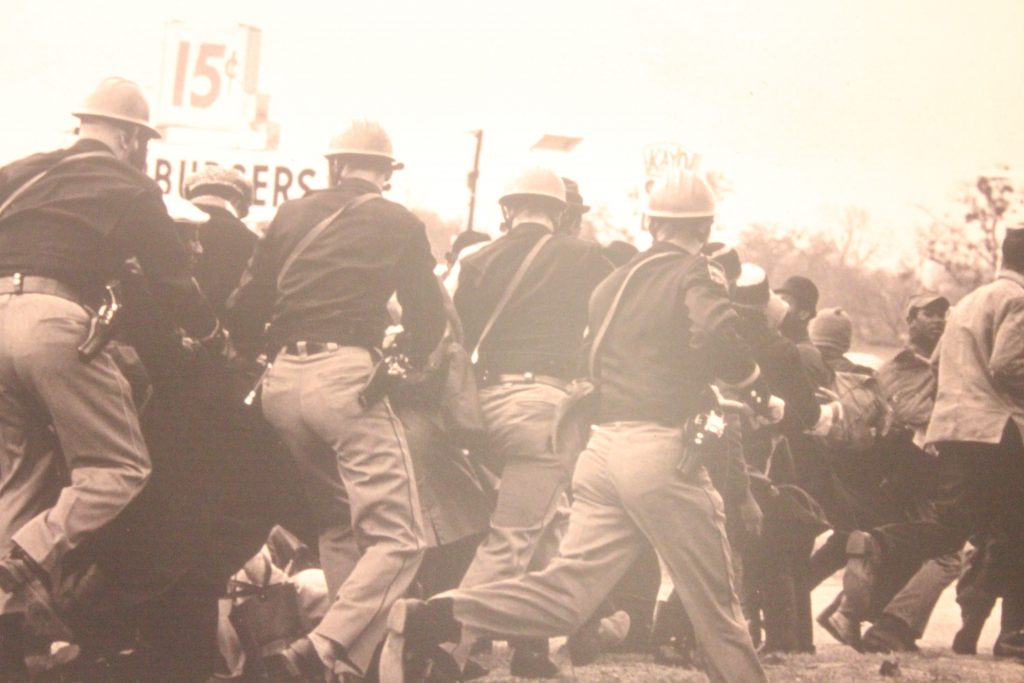Story by: Rhyan Darby
A black-and-white photograph at the Civil Rights Institute in Birmingham, Alabama, captures young protestors staring down police dogs—children caught in a battle for basic rights. Decades later, on the other side of the country, images from ICE protests in California show teenagers holding signs and facing off against armed officers. Though separated by time and geography, both scenes reflect a shared struggle: communities demanding to be seen, heard, and treated with dignity.
The connection between the Civil Rights Movement of the 1960s and modern-day protests against U.S. immigration enforcement reveal how the echoes of past movements continue to shape the voices fighting for justice today.
In the early 1960s, Birmingham, Alabama became a central battleground for the Civil Rights Movement. Peaceful protestors, many of them students, faced brutal violence from police forces determined to maintain segregation.
According to the City of Birmingham archives, approximately 1,000 students marched for desegregation in May of 1963. These protests, led by figures such as Dr. Martin Luther King Jr. and the Southern Christian Leadership Conference, aimed to dismantle the deeply rooted systems of racial discrimination in the South.
The brutality on display on Birmingham shocked the nation. Photographs of children being thrown across streets by water pressure and locked in police wagons forced a reckoning with the state-sanctioned violence used to uphold segregation. These images became a catalyst for the passage of civil rights legislation and continue to symbolize the power of nonviolent protest.
More than 50 years later, a new generation of protestors has taken to the streets, this time in opposition to the U.S. Immigration and Customs Enforcement agency, better known as ICE. Particularly in California—home to millions of immigrants—protests have erupted in response to policies like family separation at the U.S.-Mexico border, detention of undocumented minors, and raids on immigrant communities.
Lois Beckett, a reporter for The Guardian, quotes Chris Zepeda-Millán, an assistant professor in the Department of Ethnic Studies at University of California, Berkeley, in an article, “The generation that you see out there, showing up by the tens and hundreds now, to confront raids, this is the generation of youth that were politically baptized during the Black Lives Matter movement.”
Protestors have gathered outside detention centers and government buildings, holding signs that read “No human is illegal” and “Abolish ICE.”
Much like Birmingham, young people have played a key role in organizing and leading these protests.
“Hundreds of students … walked out of class Thursday to show support for a classmate… deported to Guatemala,” said Nicole Asbury, a reporter for the “Washington Post.”
Student groups, grassroots organizations, and community leaders have marched, rallied, and spoken out against what they see as an immigration system that dehumanizes and targets vulnerable families.
Both the Civil Rights and ICE protests center around a common demand—human dignity. Though the faces and policies have changed, the underlying fight remains: the battle against systemic injustice, state violence, and dehumanization.
Charles Woods III, an education director at the Birmingham Civil Rights Institute, said, “They would be proud to know their legacy did not die. It transformed. Today’s protestors may be fighting a different system, but the heart of the struggle is the same—demanding humanity in the face of injustice.”
This thread connection past and present is not just symbolic—it’s tactical. Today’s activists often borrow directly from Civil Rights-era strategies: peaceful marches, sit-ins, and community organizing. They use social media the way past activists used news cameras—to broadcast the truth and force public attention. The similarities between the two eras show how protest remains one of the most effective tools in holding institutions accountable.
Visually, the echoes are just as striking. One photo from Birmingham in 1963 shows children being beaten by police enforcement. A similar image from an ICE protest in summer of 2025 shows police enforcement using harmful weapons against peaceful protestors. Both images show fear, resistance, and strength. Both show what happens when people demand justice from systems built to deny it.
The Civil Rights Movement may belong to the past, but its lessons and legacy are far from over. As protests continue across the country—whether for immigration rights, racial justice, or other causes—they carry the voices of those who came before. The marches in Birmingham made the country listen. The ICE protests ask whether it has learned anything.
As long as injustice exists, there will be people who rise to meet it. Their signs may change. Their chants may evolve. But their fight—and their—purpose—remains the same.
And the voices are only growing stronger.

Tyler Kingkade / NBC News

Daniel Cole / Reuters

Rhyan Darby
